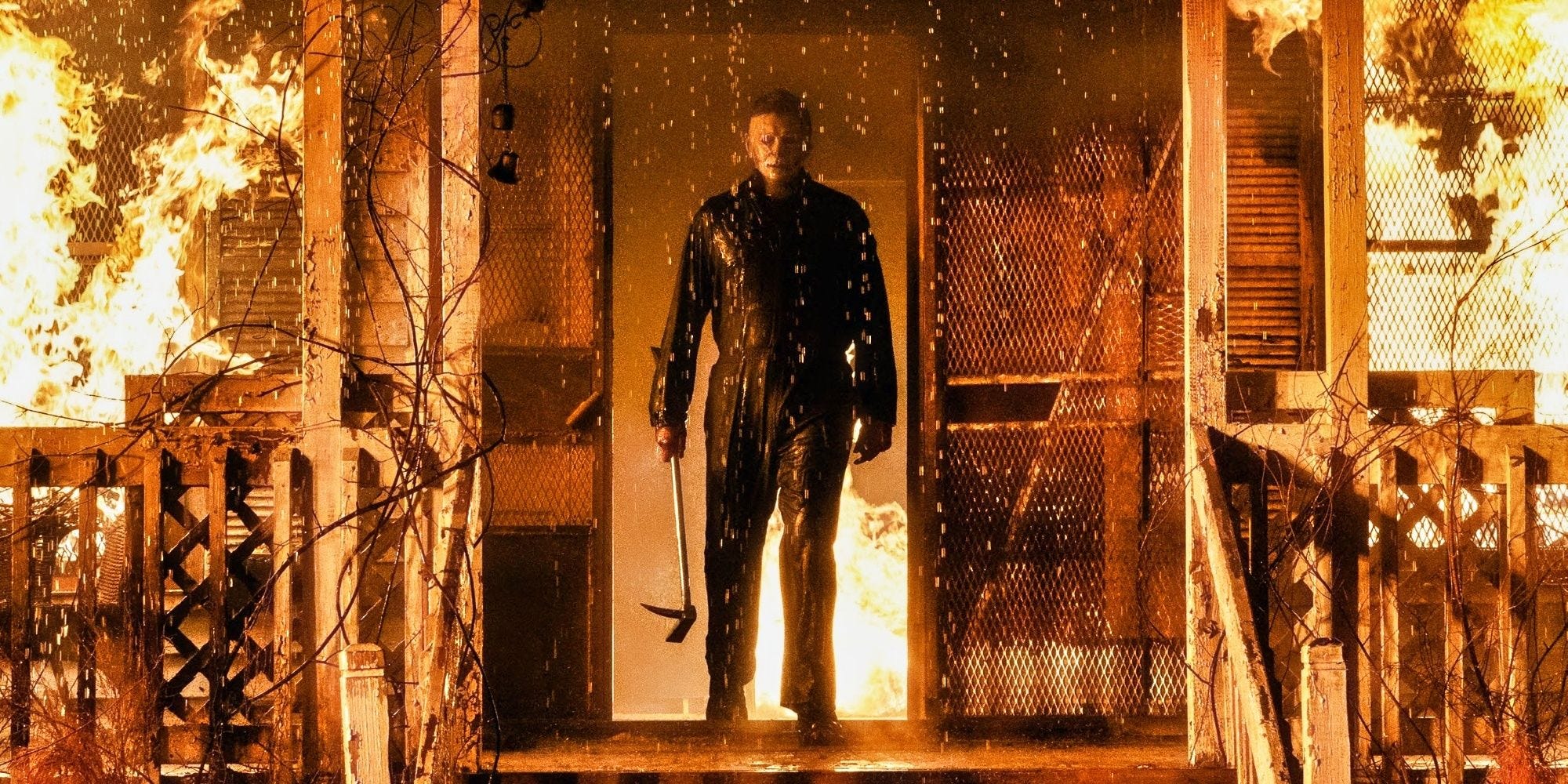
The sordid events that took place that one Halloween night in Haddonfield, Illinois are a work of fiction. And yet, it’s 2021 and we’re still ever-fascinated by the inexplicable carnage that occurred over forty-years ago in John Carpenter’s original Halloween (1978). Part of that appeal stems from the unexplainable mystery surrounding sister-killer turned serial-killer Michael Myers. Although often portrayed as either a flesh and blood behemoth or a supernatural (and theological) representation of Evil, the best incarnations of this long-running franchise have always recognized that he is, first and foremost, an enigma. That iconic mask betrays no semblance of humanity — there is no way for us to identify with the monster we see. If there’s any meaning to Michael Myers, it’s only that which we have imparted upon him. Perhaps that’s why, even in the age of ‘sequelitis,’ the Halloween series remains eternal.
Numerous sequels and a flawed remake duology later, and Michael Myers once again comes home in David Gordon Green’s Halloween Kills. A follow-up to the director’s previous Halloween (2018) — itself an extraordinary sequel to Carpenter’s 1978 feature — this entry is angrier, gorier, and even more ambitious. Continuing directly after the last film’s explosive conclusion, Halloween Kills picks-up with Laurie Strode (Jamie Lee Curtis), her daughter Karen (Judy Greer), and granddaughter Allyson (Andi Matichak), watching as firefighters approach the house where the trio left Michael to burn. Unwittingly freeing Michael from a fiery grave, the firefighters (and many more by the night’s end) meet their doom in a gruesome massacre straight out of a Game of Thrones episode. If Halloween (2018) was a story occupied with generational trauma, then Halloween Kills broadens that horizon to instead focus on multiple parallel narratives reckoning with communal trauma. As word of The Shape’s presence spreads, the town of Haddonfield coalesces around one common goal: to hunt down and make sure that Evil Dies Tonight.
Halloween Kills is, overall, a solid and entertaining foray back into David Gordon Green’s sprawling take on Haddonfield. For those already averse to the writer-director’s combination of horror-cum-cringe-comedy, then I can confirm that Halloween Kills won’t help change your mind. Gordon Green (and co-writers Danny McBride and Scott Teems) double-down on their chosen aesthetic, and it’s a breath of fresh air when compared to the ponderous and self-serious horror of the post-A24 era. Though these movies have their own sui generis flair, the slow-moving eerie stylization of dread is only growing more tedious. Sure, Halloween Kills recognizes it’s a schlocky piece of genre camp, but that doesn’t distract from the movie’s brave exploration of concepts we often don’t see from these corporate franchises.
Themes of communal trauma and the futility of mob mentality hardly scream Halloween. And yet, from the film’s opening sequence — an extended flashback set at the end of Halloween (1978) — we’re led to understand that Laurie Strode isn’t the only one out for Michael’s head. After Michael’s escape from that film’s end, a young Deputy Frank Hawkins (played in the present-day by Will Patton) nervously chases him through the suburbs of Haddonfield. Gordon Green and cinematographer Michael Simmonds exactingly recreate detail-by-detail the atmosphere and look of Carpenter’s original movie with postmodern panache. So after Hawkins and his partner (an appreciated Jim Cummings cameo) enter the Myers household to investigate, it’s clear that a thematic bridge is being built so as to link the trauma of the past to the resurgence of evil in the present.
Many have maligned the strategic choice of side-lining Laurie Strode (who was last seen with a gaping knife wound on her abdomen). Beyond serving as a way to expand upon the story’s other significant characters — such as returning figures Tommy Doyle (a committed Anthony Michael Hall), Lindsey Wallace (Kyle Richards), and Lonnie Elam (Robert Longstreet) — Laurie’s sidelining serves as a reminder that fear and trauma spread far. As the citizens of Haddonfield, now long tired of the faux-justice served by the police, begin to take the law into their own hands, questions of dangerous groupthink are proposed. Sadly, the movie doesn’t know whether to condone or condemn Haddonfield’s mob mentality, with two individual scenes framing groupthink in opposing lights. This lack of tonal coherence is exacerbated by the fact that Jamie Lee Curtis is left giving at least two lazily written monologues about the power of fear, succinctly summarizing the film’s thematic occupations for those caught snoozing.
But although Halloween Kills occasionally hits-and-misses in regards to its greater themes, Michael Myers’ butchering of the town never does. Compared to this movie, the cold-hearted kills of Halloween (2018) — and any other previous Halloween movie for that matter — look immensely tame by comparison. I’d have to estimate that Myers’ kill count quadruples, and fortunately, Gordon Green’s style has also evolved from the slick-but-restrained murders of the previous movie. He embraces the gore here, crafting some of the most gloriously demented character demises I’ve had the pleasure of viewing in a mainstream horror blockbuster.
David Gordon Green and Halloween Kills make no apologies. A blockbuster that boldly stakes out its own path forward, all the while never compromising on the central draw of these movies: watching a masked weirdo slaughter some ridiculously dense sheeple. Neither the masterpiece that Jamie Lee Curtis resoundingly heralded the movie as nor a stain on the franchise’s (already quite muddled) legacy, Halloween Kills remains a delightful piece of All Hallows’ Eve fun.